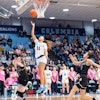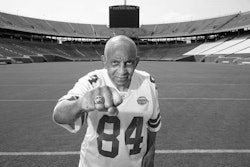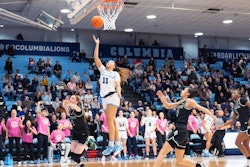On Jan. 15, Martin Luther King, Jr., Day, the Centennial Conference announced its creation of a three-year strategic diversity, equity, and inclusion (DEI) plan, uniting the conference’s 11 private, Division III institutions in a shared mission to make their athletics programs a place where all students, particularly those in marginalized populations, feel they belong.
 Dr. Ajhanai Keaton
Dr. Ajhanai Keaton
“We think it’s crucially important for the growth and development of student athletes and for everyone involved that we have DEI, always. We want to be leaders in that,” says Hoeg.
The strategy is groundbreaking. While some independent athletic organizations and institutions may have created their own internal DEI plans, Centennial is the first conference to publicly prioritize DEI and promise to track their institutional and conference-wide progress on those initiatives. This both acknowledges the steps these 100-plus-year-old member institutions have taken on their own and the room left to improve. Experts say that Centennial’s plan is leading the way at a time when DEI programming and supports, particularly in Southern states with athletic powerhouses like Alabama, Texas, and Florida, have come under legislative attack.
Hoeg says the timing of their announcement was purely coincidental, as she and the 11 institutional leaders on the Centennial President’s Council have been working to assess and align their campuses’ DEI policies since before 2022, when Centennial released its Student-Athlete Inclusion Policy.
“The states where the terminology DEI is under attack — we didn’t see that part coming,” says Hoeg. “[We’re] fighting the good fight for equality and inclusiveness. Knowing the state of affairs right now in DEI, I’m really happy we are working on it.”
Developing a plan
The National Collegiate Athletic Association (NCAA) has encouraged DEI programming since 2010, and it even offers a framework for institutions to build supportive environments for their athletes. But Dr. Ajhanai Keaton, an assistant professor in the Department of Health and Sport Sciences at the University of Louisville, Kentucky, says that, while the NCAA’s policy has good intentions, there are no clear repercussions for athletic departments that do not include DEI programs. Keaton says the NCAA DEI office lacks the resources to monitor how, and if, NCAA institutions are complying, which becomes even more complicated in states restricting the use of state funding for DEI.
Most athletic DEI plans arose in the wake of the 2020 murder of George Floyd and killings of others like Breonna Taylor, which brought a wave of activism and unity to the sports world. The National Football League painted “Black Lives Matter” across endzones and appliqued the motto to jerseys. Now, athletic departments in states disrupting DEI programming are eerily quiet, says Keaton.
“All these athletic departments vowed to promote DEI — they had T-shirts, walk outs — and now they’re silent,” says Keaton.
Dr. Ezinne Ofoegbu, an assistant professor of educational leadership at Santa Clara University, California, agrees. She and Dr. Leslie Ekpe, an assistant professor for the Department of Higher Education and Learning Technologies at Texas A&M University-Commerce, Texas, wrote in the Journal of Issues in Intercollegiate Athletics, “Walk it Like You Talk It,” an analysis of the DEI announcements from institutions in the wake of George Floyd’s murder.
“In these last four years, we’ve seen some states where that rhetoric backtracked,” says Ofoegbu. “Turning our backs on DEI work ignores a big population of our students, staff, and institutional leaders who would not be on our campuses were it not for programs that intentionally recruited them — programs that brought them in and made college accessible, or campus community centers that gave them a space to go to see people who look like them and experience life like them.”
Centennial’s strategic plan includes three areas that will be directly impacted by their DEI-focused initiatives: 1.) the creation and implementation of DEI-related programming and learning opportunities, 2.) a dedication to communicating DEI updates and events broadly for mass awareness, and 3.) an expansion of DEI initiatives already happening at Centennial institutions, including hiring for coaching, staff, and administration that looks more like the student-athletes they serve. All these initiatives will be assessed yearly in reports that identify both progress and areas for improvement.
Dr. Kathleen E. Harring, president of one of Centennial’s founding institutions, Muhlenberg College, and chair of the president’s council, says this plan thoughtfully combines the DEI initiatives happening separately at member institutions and gives them all goals toward which to strive.
“At Muhlenberg, all our student groups are active about learning more about bias, ways they can be biased, ways they can disrupt biased situations,” says Harring. “We shared our own practices in terms of the work we’re doing on campus to increase equity, inclusion, and belonging. We shared areas where we thought there needed to be more support, and training was one of those, not just with staff but student athletes.”
Hoeg, Harring, and others are hopeful that, by making their DEI support public, student-athletes may opt to attend one of the Centennial institutions. But it’s not an easy choice to put on students, says Ofoegbu, especially considering the role Name, Image, and Likeness (NIL) plays as a student calculates which institution will bring them more attention.
 Dr. Ezinne Ofoegbu
Dr. Ezinne Ofoegbu
Ongoing challenges
New anti-DEI legislation “exacerbates, legalizes, and normalizes” the estrangement student-athletes might feel, says Ofeogbu.
Dr. Molly Harry, an assistant professor of recreation and sport management at the University of Arkansas, says student-athletes are more likely to choose their college based on scholarship amounts, proximity to home, playing time, and the potentiality of NIL deals. But, she adds, “not considering social justice issues or DEI may speak somewhat to the socialization process of sports that hyper-focuses on athletes’ physical development and their athletic identities over other developmental areas and identities,” an attitude Harry says is shaped by the U.S. athletic system and not the athletes themselves.
“When schools in Florida and Texas, especially at the big-time levels, still have some of the strongest athletic programs, best scholarship opportunities, fanciest facilities, NIL collectives — those things can perhaps ‘make up’ for anti-DEI legislation,” says Harry. “However, for the more critical and aware athletes, I can see these changes perhaps prompting them to reconsider their enrollment. And now with the transfer portal leniency, there could be some athletes who consider transferring due to the ramifications of the anti-DEI stuff that is in the works.”
It’s not just athletes of color that are impacted by anti-DEI legislation, says Harry, but all individuals who experience life on the margins, like gender expansive athletes or other LGBTQ individuals, students from different socio-economic backgrounds, and other intersectional areas.
“DEI plans must include input from the college athletes themselves. They’re the ones who will arguably be most impacted by these plans,” says Harry. “By including athlete representatives, athletic leaders can, at least, work toward goals athletes actually want when it comes to DEI but also solidarity with this group.”
 Dr. Kathleen E. Harring
Dr. Kathleen E. Harring
“The sessions were informative, thought-provoking, and forward-thinking,” says Buck Jones. “DEI plans are essential for institutions to create inclusive and equitable environments where all individuals have the opportunity to thrive and contribute to the institution’s success. Plans are strategic, intentional, and public.”
In creating their plan, Harring, Hoeg, and Buck Jones agreed that having an external thought-partner was critical to their success, as was a complete buy-in from institutional leadership that DEI is critical to building successful athletic programs and learning environments. It’s something experts say can be replicated and re-created in other athletic conferences.
“Thinking about academic histories and rich traditions, I’m excited the Centennial Conference [members] are on the forefront of this,” says Keaton. “When doing DEI, there’s always the issue, where does legitimacy come from? It comes from the conference office you’re a part of. So, you don’t have to question why you do it, it’s a collective effort — all departments bought into it. Sports is so visible in areas where DEI is trying to be erased, it’s a huge opportunity for conference offices to step up.”
Keaton and Ofoegbu agree they are excited to see the numbers produced by Centennial’s annual review of their DEI progress, to find out whether the changes will make an impact in a field where the majority of athletic directors and coaches are white.
“I’ll be on their site a year from now, seeing how they’ve done the work and if they truly walked it like they talked it,” says Ofoegbu. “I definitely think Centennial Conference has established a model that other conferences and institutional athletic departments can and should follow.”
When athletes are appropriately supported in their environment, they succeed not only on the playing field but in the classroom as well, says Keaton.
“We have to create circumstances and situations where we’re taking young adults and thinking about how they are developing to become young professionals,” says Keaton. “At times, that means creating intentional programming efforts that promote equity on their behalf.”



















